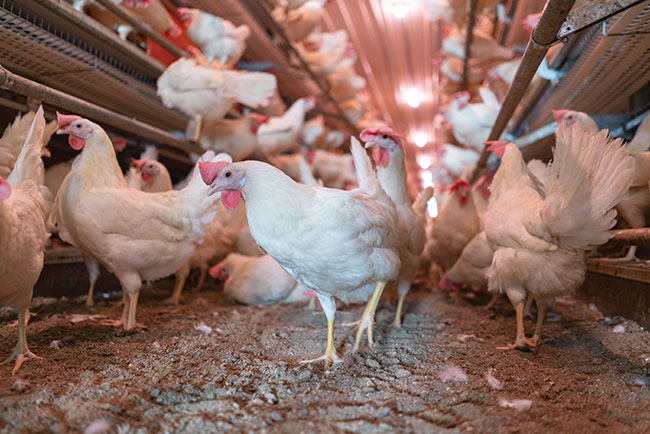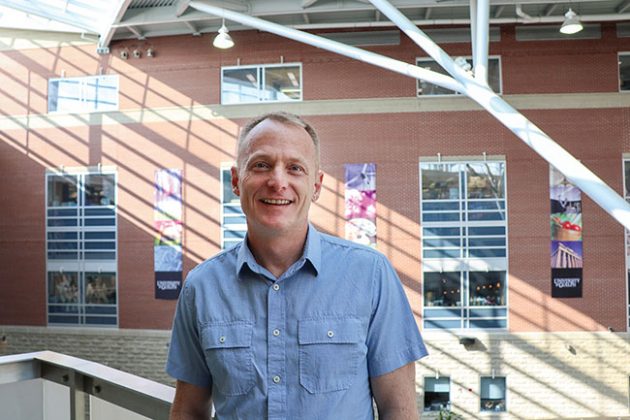
Poultry barn ventilation a balancing act
By Lisa McLean
Features Barn ManagementUnderstanding your barn in different climate conditions is key to better air quality.
 Van Heyst recently completed air quality studies of cage-free egg barns in Saskatchewan and Ontario. PHOTO CREDIT: Big Dutchman.
Van Heyst recently completed air quality studies of cage-free egg barns in Saskatchewan and Ontario. PHOTO CREDIT: Big Dutchman. Air quality concerns are a known problem on many Canadian poultry operations because emissions of particulate matter and ammonia are difficult to balance. Now, thanks to ongoing evaluation of various air quality control strategies, producers are better positioned to adopt tools that meet environmental, economic and animal welfare requirements for producing more sustainable eggs and poultry meat.
Bill Van Heyst, professor of environmental engineering in the School of Engineering at the University of Guelph, has spent nearly a decade evaluating air quality control strategies in use on Canadian poultry operations. He conducts measurement campaigns on various farms to collect data points, including indoor concentrations of pollutants, barn ventilation rates, samples from excreta, as well as other barn parameters such as indoor and outdoor temperatures and humidity levels.
“Recently, we’ve been specifically looking at problems with ammonia and particulate matter,” Van Heyst says. “Ammonia is generated when barns have wet litter conditions, and particulate matter is generated in dry, dusty scenarios. Farm operators have to find this happy medium in terms of their litter management so moisture content doesn’t favour one side or another.”
As part of his team’s project, Van Heyst recently completed studies of cage-free egg barns in Saskatchewan and in Ontario, across various seasons. He is leading similar work in broiler breeder barns in Ontario.
Dry conditions create particulate matter
“Cage-free housing systems allow the birds to have more movement, and that leads to higher levels of particulate matter in the barn,” Van Heyst says. “As litter accumulates, it contributes to air quality issues through buildup of either ammonia or particulate matter.”
Particulate matter is easy to spot in a barn setting because the air appears dusty. Van Heyst’s research has revealed particulate matter is a bigger problem in the prairie provinces, where winter conditions are dry, and barn ventilation evaporates moisture off of the litter pack. He notes size fractionated particulate matter is a nasty toxin that poses a human and animal health risk and is declared toxic under the Canadian Environmental Protection Act.
Humid conditions boost ammonia levels
Conversely, humid winters more common in southern Ontario often lead to moisture finding its way into the barn, especially around air intakes as moisture condenses. Ammonia is common in barns with humid weather conditions, and it is more difficult for the average farm to monitor. Van Heyst says most people entering a barn may notice ammonia through a burning feeling in their eyes, but they will grow accustomed to it fairly quickly, and they might not register a problem.
Van Heyst says poultry barn ventilation is typically triggered off of temperature difference only, but secondary conditions such as carbon dioxide and ammonia levels are also reasons to increase air flow. If carbon dioxide levels get too high, birds may become sleepy. If ammonia is too high, it may lead to eye and respiratory tract irritation. Prolonged exposure to high levels of ammonia can even lead to blindness in birds.

Bill Van Heyst is professor of environmental engineering in the School of Engineering at the University of Guelph. PHOTO CREDIT: Bill Van Heyst.
Understand your barn
“Managing these toxins is a balancing act and seasonal conditions across geographic locations can put that balancing act into question,” Van Heyst says. “Farmers really have to understand their own barn and how it performs in different conditions – even a new barn might take a few flocks to get ventilation under control. Once you understand it, it’s easier to use.”
He also notes that tools and strategies for managing air flow are never one-size-fits-all and a solution that fails to meet economic, environmental and animal welfare needs is not truly sustainable. It’s important that producers and researchers collect data to inform how new strategies perform in specific environments.
Know what your tools can do
Most recently, Van Heyst’s team conducted a measurement campaign at a broiler breeder operation in Ontario that had installed a manure belt under the roosting areas. Later in 2021, he plans to take the same measurements at a similar operation in Ontario that does not have a manure belt.
“Broiler breeder operations are an interesting mix between cage-free layers and broilers, because the birds roam like broilers, but have fewer nesting areas than layers,” Van Heyst says. “Traditionally, broiler breeder operations do not have a manure belt and excreta builds up over time. With this project, we’re interested in whether the installation of a manure belt actually reduces the amount of ammonia the birds are exposed to.”
He notes that even with a manure belt removing excreta, the barn developed a moisture problem and registered high ammonia levels shortly after placing a new flock in winter. The farm operator worked quickly to address the issue and bring ammonia levels down. As part of the project, his team is putting hand-held ammonia analyzers to the test to see how accurate their readings are compared to his team’s more advanced monitoring equipment.
Each of Van Heyst’s measurement campaigns last from six months to one year, and each one assesses control strategies to reduce or mitigate ammonia and particulate matter from Canadian poultry operations. To date, his team has also assessed the use of water sprinklers, poultry litter treatment and a centralized air exchange system.
This project is expected to be completed by 2023.
This research was funded by the Canadian Poultry Research Council as part of the Poultry Science Cluster, which is supported by Agriculture and Agri-Food Canada (AAFC) as part of the Canadian Agricultural Partnership (CAP) program. Additional support was received from Egg Farmers of Canada, Canadian Hatching Egg Producers and the School of Engineering, University of Guelph.
Print this page